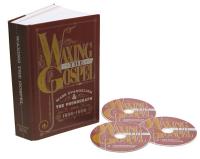Digging Into the Liturgy of the Phonograph's First Eleven Years
I first met Mr. Lozaw in the 1970s when the Hi-Fi store for which I was producing radio commercials decided to run a radio commercial contest and Mr. Lozaw's submission won.Ed.
Archeophone, the Champaign, IL label that specializes "in making the world's oldest records accessible," has outdone itself with the Grammy-nominated Waxing the Gospel set, which focuses on the first 11 years of the phonograph. Waxing the Gospel's impressive, nearly painful detailing and historic research of century-old religious recordings, richly illustrated with restored photos and artwork, is, in and of itself, an academic marvel.
The collection is sure to excite the Christian music enthusiasts among us -- for instance, it includes the only recording made by revered blind hymn-writer Fanny Crosby. But the real joys here are the between-the-lines revelations about the gramophone and phonograph in their infancy and how they quickly grew to change the way we regard and listen to music, which up to that point could only be a fleeting delight.
Much of the 408-page book and the 102 tracks on 3 CDs center around unconventional evangelists Dwight Moody and Ira Sankey, whose unorthodox revival-tent preaching and singing styles were frowned upon by much of the day's religious establishment. That didn't stop the duo -- sort of Calvinist rock stars, if you will -- from becoming a late 1800s juggernaut with a publishing empire in an original analog format -- sheet music of Sankey's simplified arrangements. Moody and Sankey hymns even made it onto wind-up music boxes. Together, they toured the revival circuits in the US and England like rockers would hit arenas today.
Then, with their foray into recording wax cylinders, the duo helped changed sacred music's focus from hymns sung by mass congregations to soloists who enchanted listeners with their disembodied voices. Most of the Moody and Sankey-produced recordings in this set are in the Celebrity category, collectible more for who was singing than what they were singing. But the duo's successes in music publishing didn't translate into early gold records. They were facing the same issues as others with the nascent industry's growing pains.
The earliest recordings were true one-hit wonders, recorded on tinfoil that could not be removed from the recorder without destroying it. With the rise of Edison wax cylinders, some recordings -- like the oldest surviving instrumental version of "Rocked in the Cradle of the Deep” -- became hits in saloon nickel-slot machines. But expensive ($150), cumbersome (80 lbs.), lead-acid battery player-recorders, and stunted distribution meant that most "talking machines" of the day were limited to such novelty and being toys of the wealthy, which led to mostly amateur use and recordings that have been lost to the ages.
It wasn't until the late 1890s when the Edison Phonograph and the Bell-Tainter Gramophone became available in relatively inexpensive ($25) spring-loaded units that could both play and record that use became more common. Cylinders even found use in the reciting of marriage vows and burial rites when ministers weren't available.
Still, producing copies of recordings to distribute and sell was a problem. Methods including making acoustical copies by making second-generation copies while the original was played, or mechanically tracing of grooves from one wax cylinder to another, resulted in poor sonic quality. It wasn't until 1902 that cylinders or discs could be mass produced from a single master, which makes the tracks restored and preserved on Waxing The Gospel even more significant.
The set's three compact discs are divided into three categories of records:
Commercial releases;
Celebrity recordings;
and Vernacular records, often produced at the camp at Ocean Grove, NJ, or by families in their homes, or other field recordings. Each of the 102 recordings -- a total of nearly four hours worth -- is accompanied by a detailed background and lyric sheet, complete with biographical artist sketches. While some tracks have clearly suffered from the abuses of time, it's surprising how relatively clear (if frequency limited) some of the recordings have remained.
One of the most popular recordings included features not singing but the chimes of New York's Trinity Church ringing out "Nearer, My God To Thee," each wax cylinder recorded individually and selling for $2.25, more than twice the price of other records even though the process of recording the chimes up-close stripped them of much of their warm, bell-ish charm.
Although there are some exceptions, for the layman most of the tracks here are more enjoyable for the usefulness and amusement of historic soundtracks than musical entertainment. But no matter how you approach it, the mind-boggling scope of Waxing the Gospel is worth the effort.
You can sample tracks from all three CDs and/or order the set on the Archeophone Records website.


